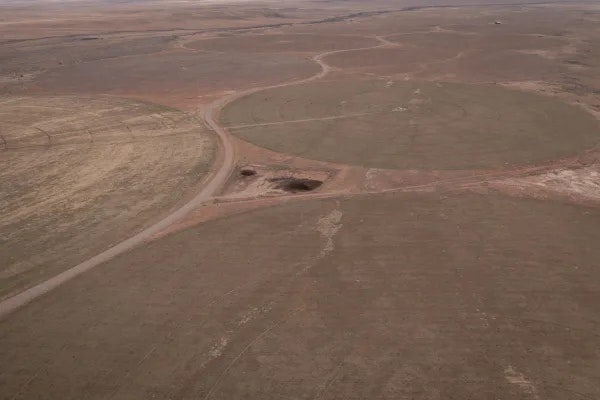Ongoing Drought

Southwest Colorado’s ongoing drought hurts–and it’s not new.
Southwest Colorado has experience drought a majority of the past 20 years. While summer monsoons staved on wildfire and rejuvenated soils, the drought in southwest Colorado is not over.
In 2021, Montezuma County irrigators and the Ute Mountain Ute Tribe suffered acute and devastating financial impacts from consecutive years of drought conditions. The Dolores Water Conservancy District had to enact penalties for water overuse and exhaust most of their reserves to keep water costs reasonable for strapped farmers. Fish populations and the recreationists that follow them suffered, with fishing bans on the San Miguel and Dolores rivers. Colorado Parks and Wildlife reported the potential loss of a highly valued rainbow trout fishery on the lower Dolores River. The Town of Dove Creek had to act to ensure late summer municipal water supply was available when there wasn’t enough water to push deliveries through their canal.
How are local communities responding?
The severity and duration of the current drought has highlighted for SWCD the value of our reservoir storage in mitigating the impacts of variable snowpack. We can use this knowledge to look for opportunities to better manage our existing storage vessels in times of drought, as DWCD has done with dredging, and seek small scale reservoir opportunities like what the Town of Dove Creek has done. Local municipalities are also taking the lead in bringing awareness to drought. The Town of Bayfield, for example, adopted their first official drought management plan in summer 2021, creating a system of conservation restrictions and fines that would take effect during drought periods. The City of Cortez has limited outdoor watering in 2022 to the early morning and late evening and encourages residents to water every other day.
What is SWCD doing to help?
Advocacy
- SWCD supported the state’s emergency drought declaration can enable key federal agencies to take action to support local growers and water managers.
- The SWCD board supports increased state funding for implementation of Colorado’s Water Plan, including the completion of local projects that provide supply redundancy, improved infrastructure, robust water planning, and other tools that will help southwest Colorado build resiliency in the face of aridification.
- SWCD along with other entities across Colorado came together to support the western water infrastructure package and projects in southwestern Colorado are working to access those funds.
- Together, these and other programmatic and funding strategies can provide a framework that will help us to respond to the challenges faced in our District and across Colorado.
Education
- “Navigating Shortage” was the focus of SWCD’s 2022 Southwest Water Seminar. Regional and local climate professionals relayed data showing southwest Colorado squarely in the bullseye of a regional aridification trend. Tribal leaders discussed their local and regional water future. Keen local negotiators reviewed Colorado water’s central aspiration: striking the balance between multiple needs in times of drought. Attendees also heard about several local efforts to improve water quality while flows drop. All these presentations are available on SWCD’s YouTube Channel and tell the story of drought in southwest Colorado.
- SWCD is a regular source for local journalists reporting on snowpack, water supply, and drought.
Current conditions:
- The U.S. Drought Monitor provides the latest drought designations for the State of Colorado.
- The Colorado River Basin Forecast Center shares information on water supply, river conditions and snowpack.
- SWCD’s Water Quick Links page guides constituents to area stream flows, reservoir levels and snowpack.
Southwestern Colorado’s drought story:
See reports from across our District on the acute impacts of drought. Please email additional articles to info@swwcd.org:
- How this tribe survives in Colorado’s worst drought region with as little as 10% of its hard-won water supply (Denver Post, July 10, 2022)
- Q & A with Ute Mountain Ute Tribal Chairman (Colorado Sun, June 11, 2022)
- Rafting outfitters had record revenue in 2021. Will it keep them afloat? (Colorado Sun, May 20, 2022)
- Do farmers and ranchers take stock of mental health? (Durango Herald, May 16, 2022)
- Water managers see early runoff as positive sign (Durango Herald, April 28, 2022)
- Durango dodges problems with low reservoirs, but subject to rivers’ whims (Durango Herald, April 8, 2022)
- For ranchers, adjusting to drought requires innovation, planning (Cortez Journal April 4, 2022)
- Punished by drought, some southwest Colorado farmers survived 2021 on 10% of their normal water supply (Colorado Sun, April 3, 2022)
- Water seminar asks what prolonged drought means for Southwest Colorado (Durango Herald, April 1, 2022)
- Colorado’s Dolores River should be raging through canyons — instead it’s nearly dry (NPR, November 2, 2021)
- A Colorado town nearly ran out of drinking water (Colorado Sun, October 29, 2021)
- Dredging will provide access to last 5 feet of irrigation water in parched McPhee Reservoir (Durango Herald, August 6, 2021)
- Monsoons quench short-term drought across Southwest Colorado (Durango Herald, August 4, 2021)
- The big dry didn’t die (Telluride Daily Planet, August 4, 2021)
- Trout habitat will be lost in western Colorado drought (9News – July 8, 2021)
- Drought triggers penalties for overuse of water (Durango Herald – June 29, 2021)
- Low Flows on the Dolores River Trigger Limits on Fishing (Durango Herald – June 24, 2021)
- Bayfield adopts plan to manage conservation during drought (Durango Herald – June 16, 2021)
- Don’t stress the fish: Low flows prompt emergency declaration (Telluride Daily Planet – May 28, 2021)
- La Plata County farmers tighten belts during dry season (Durango Herald – May 25, 2021)
- Drought saps agricultural economy in Southwest Colorado (The Cortez Journal – May 25, 2021)
- Press Release – Dolores Water Conservancy District & Ute Mountain Ute Tribe (May 21, 2021)
- Despite drought rafters see strong season ahead (Durango Herald – May 8, 2021)
